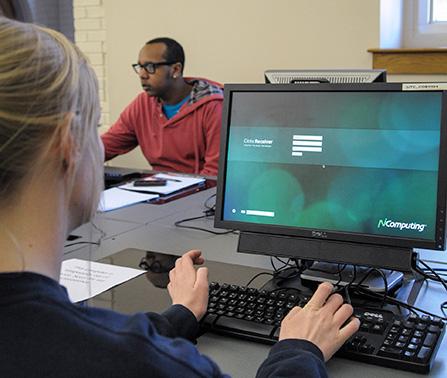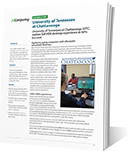DIE ERFOLGSSTORY
University of Tennessee at Chattanooga (UTC) realizes full HDX desktop experience at 60% less cost
Replacing aging computers with affordable virtualized desktops
When Thomas Hoover joined the University of Tennessee, Chattanooga, he brought valuable IT leadership expertise including first-hand experience with successful desktop virtualization. The Associate Vice Chancellor and CIO of UTC came from Pepperdine University, where desktop virtualization had enabled the school to outfit labs, classrooms and the library with thin clients for a third of the cost of PCs.

In scoping the needs of the fastest-growing educational institution in Tennessee, comprised of approximately 11,700 students and 1,200 staff and faculty, he again found numerous opportunities to replace aging computers across the campus, some of which were in excess of nine years old, with more affordable, sustainable and easier-to-manage virtualized desktops. But this time, he wanted to take it up a notch.
“I came in wanting to virtualize because I saw it as a quick way to save money and get a better user experience for our students,” Hoover said. “With the university relying more and more on video, we needed to virtualize more on an enterprise level to deliver a consistently high performance and rich end user experience.”
100% HDX experience
Hoover had used NComputing solutions in his previous role at Pepperdine University and was excited to deploy the NComputing N-series in his new role at UTC. The N-series is Citrix Ready HDX Verified and leverages NComputing’s own Numo3 System-on-Chip (SoC). In 2011, NComputing and Citrix teamed up to reduce the cost and complexity of virtual desktop integration and deliver a full HDX experience for users through the Citrix Ready SoC Program. Specifically designed for Citrix HDX, these thin clients deliver 100% of the HDX experience at a dramatically lower cost than PCs or other thin clients.
“My philosophy is if you’re going to roll out a virtual desktop, it needs to be as good or better than a desktop. With my history with NComputing, I was very impressed, and when I saw a device that would work with Citrix VDI, I got excited,” Hoover said. “We can actually save money and improve performance.”
UTC did its due diligence and put NComputing N500 thin clients with Citrix VDI-in-a-Box to the test against other Citrix-capable thin clients. Needless to say, the N500 outperformed the competition.
“The N-series really is a game changer. It’s server-based and enterprise level right out of the box,” Hoover said. “It actually works in a Citrix environment and provides 1080p video by design.”
66:1 Ratio of thin clients to host
UTC rolled out virtualized desktops in labs powering 300 workstations powered by Dell servers on a 66:1 ratio. Hoover finds the performance keeps pace with high-demand applications across the university, including Adobe’s Creative Suite.
“On a daily basis, I’m using an N-series device with a 55-inch LED for demos in my office, and I’ve been extremely impressed with it,” Hoover said. “Most people don’t even know it’s a virtual desktop.”
Hoover’s team manages the N-series thin clients centrally with NComputing’s vSpace Management Center (VMC) software and uses Citrix VDI-in-a-Box for the backend VDI management. The team can make changes on a server and update more than 60 devices all at once using VMC to schedule and automate the process of applying the changes over the network. This saves time and reduces demand on IT staff that no longer have to walk around to each individual computer to perform updates.
“When you have 100 or 500 devices, you need a good way of managing them,” Hoover said. “With vSpace Management Center’s web-based interface, we can update devices quickly, manage firmware and make sure it’s all working correctly, whenever and wherever we happen to be. My staff is very impressed with it.”
And new N-series units can be deployed in minutes. “We can literally set up a whole lab in a few hours. It’s a dream,” Hoover said. “The NComputing device allows us to scale the solution and be on an enterprise level. That was one of the things that really excited me about the product, is that we could put it out across the entire university.”
60% computing cost savings & 98% energy savings
Where UTC used NComputing, they reduced computing costs by about 60% over the cost of using PCs and about one-third over using traditional thin clients. “It’s a really quick return,” Hoover said. “You spend $1,000 to $1,200 on a computer, or you spend a couple hundred dollars on an NComputing device. It pays off very quickly.
With more room in the budget, UTC plans to invest in other technology, such as video conferencing, business learning applications and higher-end machines for engineering labs. “For the longest time, the whole farce about virtual desktops has been, it’s not a money saver at all,” Hoover said. “But it’s made a big difference here. We’re actually saving money.”
Virtualization is a model that provides major ongoing cost savings during initial installation, during refresh cycles and on electricity usage. UTC sees the move to NComputing as a “green-friendly initiative.” Each device consumes just .005 kWh of power compared to the traditional PC usage of .2kWh – a savings of 98% on energy use. Hoover calculates the ROI on the energy savings alone at 7.9 years.
‘Opens the door’
Next, UTC plans to increase the number of N-series thin clients to about 500 throughout labs, which total more than 50, staff offices and the new library. Further down the road, Hoover envisions virtualizing at least one- third of computing labs with NComputing and Citrix VDI-in-a-Box.
For class enrollment or while hosting conferences, UTC can quickly set up and take down kiosk machines with NComputing. Using the N500w wireless thin clients, the university can setup digital signage as needed or enable faculty members to conduct interviews via Skype in conference rooms all over campus. “I can buy an NComputing device and a web cam and I’m out $250 instead of $1,000 or more,” Hoover said.
“In the end, NComputing actually allows us to use a virtual desktop across university on an enterprise level, thus reducing our costs and our energy consumption and at the same time giving our students, staff and faculty a better user experience so it’s a win-win situation,” he added. “It also allows us to focus more of our limited funds on student retention, student success and important area where we really should be spending our resources.”
Suggested reading





